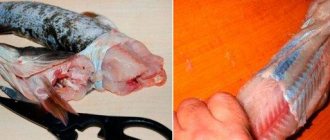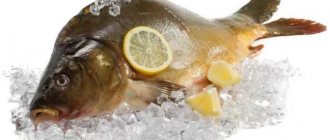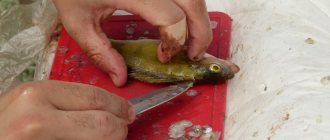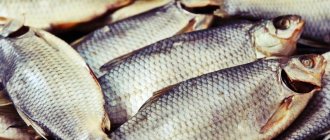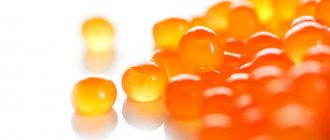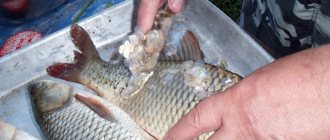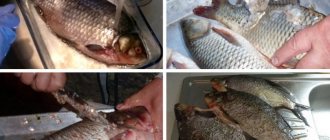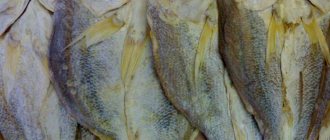The benefits of fish are great. This is not only a tasty delicacy, but also a source of large amounts of vitamins and microelements. Cleaning fish from scales is considered one of the unpleasant processes in cooking, since during cleaning small scales scatter throughout the kitchen.
It is because of this process that many housewives refuse to cook fish. And male fishermen prefer to catch rather than clean it. Now, in order to facilitate the process, there are a large number of methods and devices that will simplify cleaning and keep the kitchen free of dirt. In fact, there is nothing complicated in this process; the most important thing is to choose the right device with which you can clean the fish.
Tips on how to clean fish
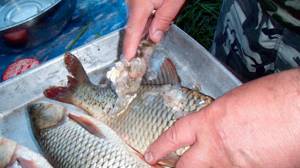
Remember that fresh fish is much easier to clean, so the entire catch must be cleaned at once and then stored.
- The best option would be to clean the scales near a pond.
- Choose only high-quality sharp knives for cleaning, otherwise your hands will be cut. The knife should be sharp, wide, but not long.
- Cleaning should only be done on a special cutting board designed for fish.
- Carefully clean the scales, because carelessly cleaned fish will be more difficult to cook and will not taste as good.
- Before cleaning, be sure to place the fish in cold water with vinegar.
- Any fish can be cleaned easily if you insert a stick into its mouth all the way or use an awl to pin the tail to the board where the fish will be cleaned. Next, the fish should be pulled out until it “crunches,” holding it behind the eyes with your fingers.
- To prevent the fish from jumping out of your hands, wrap the tail with a napkin or towel. If there are no abrasions on the skin of your hand, rub it with salt.
Cleaning process
Before cleaning begins, no matter what type of equipment is used, the fish should be prepared for this process. To do this you need to do the following:
How to quickly clean carp
- Live fish should be stunned so that they do not resist.
- Trim fins. This can be done using scissors.
- Place the fish on a cutting board and secure the tail. In this case, it is desirable that the board has a special clamp. It is recommended to wrap the board with cling film.
- You can place the fish with the board in a sink filled with water.
Next, holding the fish by the tail, use a cleaning device to begin cleaning off the scales, moving from the tail to the head. If a board with fish is placed in a sink, the peeled scales will immediately fall into the water and will not scatter around. After the fish is cleaned, it must be rinsed with water and gutting begins.

Board with clamp for holding fish.
How to clean fish?
One of the popular cleaning methods is a knife. But from some types of fish you don’t have to remove scales at all, for example, salmon, gobies. This fish is simply fried in a frying pan. Catfish and burbot are quick and easy to clean; just wash off the mucus from them with water or rub the carcass with salt. The scales can be easily removed from freshly caught crucian carp simply with your fingers. Small fish can be sprinkled with salt and rinsed under water. But, ruff and perch, you will have to sweat over them.
A live fish that moves and constantly beats its tail is very inconvenient to clean, so it must be stunned. Let's start cleaning. The very first and most important step is to rinse the carcass under running cool water. It is necessary to wash the gills and body of the carcass well. You can clean with a regular kitchen knife, a special fish knife, as well as fish scalers and scrapers.
Hand tools

The mechanical cleaning method is the fastest, but not effective. Large fish can be cleaned by hand. Grasp the tail with one hand. The cleaning itself occurs with your free hand, that is, with your thumbnail across the growth of the scales. Use a knife to clean in hard-to-reach places.
An ordinary kitchen knife, not very large and wide. You need to be careful with him. To prevent the scales from scattering, the carcass can be placed in a bag, in which the scales can be removed with gentle movements. If you clean in the sink, do not forget to put a metal or plastic mesh over the drain. The carcass must be held correctly. The head should be positioned towards you, you need to hold it by the tail. The process of removing scales occurs from the tail to the head. Movements are smooth and neat.
The best tools include a brush that visually resembles a hair comb. This is a flat plate with small blunt teeth. Teeth - spikes are the main working part of the tool. This design can handle scales of different sizes without much difficulty.
It is worth noting that sometimes even a vegetable knife will do. It is better to clean under running water or in a bowl of water. Mini grater for chopping vegetables, the edges of which should be sharp. There are species of fish whose scales fit tightly to the skin. Then place the carcass in boiling water for a few seconds.
Electric household fish scaler
One of the best devices that can quickly and easily clean fish scales is an electric fish scaler. Such an electrical device can be found in most fishermen, catering workers and owners of private fish stores.
A fish scaler runs on electricity and is considered the most convenient and easy-to-use tool. Home automatic scale removal machines can operate from several power sources: a household network, a car cigarette lighter, and a built-in battery. Thanks to these power options, you can use the device not only at home, but also while fishing.
Electric household fish scalers are also very popular. The most famous models are RF 01, VesElectric 4000 battery with container. Electric household fish scalers are equipped with a special screen that prevents scales from flying away.
How to clean different types of fish?
The cleaning method largely depends on the type of fish. Some species have scales so small and soft that they are left behind. Other fish are cleaned of scales, removing them along with the skin. Before you clean and cut up a fish for the first time, you need to familiarize yourself with its features.
We recommend: How to make clear ice without bubbles at home?
How to clean pike perch?
Pike perch is a very tasty and healthy freshwater fish of the perch family. It is distinguished by hard scales. In addition, it has sharp dorsal fins that can easily injure your hands. Therefore, the first thing is to always cut them off, and then fix the pike perch on a cutting board and clean off the scales with a fish scaler, a special knife or a household device. This is the case when, for easy cleaning, it will be useful to use one of the life hacks: scalding with boiling water, cleaning under water.
How to clean pink salmon?
Pink salmon has small and soft scales. However, they need to be removed even if you plan to simply salt the fish.
How to clean pink salmon from scales quickly and effectively?
- Place the fish in the refrigerator for half an hour. Clean the frozen carcass when it is half defrosted. Try not to wet pink salmon.
- Grasp the tail and lightly scratch the fish towards the head. Do not use much force to prevent the scales from flying apart.
After cleaning, the fins are cut off and the gills are removed. If necessary, you can remove the skin using a thin and long fillet knife, prying it off at the tail. They also use it to fillet fish.
How to clean mackerel?
Mackerel is one of those rare fish that does not require cleaning before cooking. Instead of scales, it has a thin skin, which, as a rule, is not removed. You just need to cut off the fins, separate the head and remove the giblets, and then cut it up at your discretion.
How to clean pollock?
Pollock is a very popular sea fish. It is affordable, healthy, contains minimal bones and is very easy to clean. Its scales are so small and delicate that many do not notice them at all. But it is still correct to clean the pollock before cooking. To do this, remove the sharp fins, and then, holding the carcass by the tail, scrape off the scales against the growth. It is best to clean pollock when slightly frozen under running water.
How to clean carp?
Carp is an artificially bred fish, domesticated carp. Its meat has a sweetish taste and is highly valued in cooking. The fish has a large, tight-fitting skin, but is easy to clean:
- Dip the carp into water acidified with vinegar (dry scales do not easily come off the skin).
- Use scissors to cut off all fins except the tail fin.
- Insert your finger under the gills to secure the carcass.
- Use the thumb of your other hand to get under the scales near the tail.
- Move it smoothly under the scales, moving towards the fish's head.
- Do the same on the opposite side. The scales will be easy to remove without scattering to the sides.
Also in cooking, scales are often removed along with the skin. To do this you need a long and thin knife with a point. They penetrate under the skin of the fish at the tail part and carefully move along the entire length. Then the layer of skin is cut off. The procedure is repeated until all the skin is removed.
How to remove gills from carp?
When cooking fish with the head, the eyes and gills must be removed. To do this, use a sharp knife - and nothing more.
To properly remove gills from carp and other fish, follow this algorithm:
- Lift the operculum.
- Stick a knife inside
- Make deep cuts from the side of the ridge on one side and the other of the head.
- Cut the gills where they join the abdomen.
- Pull it towards you and take it out.
The gills are the easiest way to determine the freshness of fish: they are the first to spoil. If they are dense and reddish in color, then the fish is fresh.
How to clean crucian carp?
A river fish that everyone knows. Crucian carp makes excellent fish soup. And if you make cuts on the cleaned and cut up carcasses, then during frying all the small bones will soften and will be imperceptible.
Just like carp, crucian carp is cleaned with your fingers:
- Place the crucian carp in a deep bowl of water.
- Cut off the fins.
- Grasp the gills.
- Using your thumb, pry the scales off the tail.
- Brush it off, moving towards the head.
We recommend: Are thyme and thyme the same thing? Where to add the magic herb?
Despite the fact that the scales of crucian carp are large, they are quite soft and easily separated from the skin.
How to clean and cut trout?
Cleaning trout does not take much time. The scales of the fish are quite small and do not tend to fly apart. Usually it is scraped off with the blunt side of a knife, holding the fish by the tail. To prevent it from slipping, sprinkle your hands with salt or wrap the carcass with a paper napkin. Then the fish is washed and cut.
Trout can be cut in different ways depending on the cooking method:
- Roasting a whole carcass. The fish's fins are trimmed. Then a shallow incision is made from the anus to the gill. Take out the insides. Remove the black film. The gills are removed. Rinse under running water.
- Fillet, for sushi and salads. After removing the fins from the small fish, remove the skin in the manner of a stocking, picking it up at the head. Then they gut and fillet the fish. Large trout are first gutted, the head is cut off, and then the fillet and skin are removed, making a neat cut from the side of the ridge. The skin can be removed later using a fillet knife.
How to clean a dorado?
Dorado fish is also called sea carp. Most often there is no need to clean fish from scales - it is sold already cleaned. But if you come across a specimen with scales, do the following:
- Cut the fins off the carcass.
- Place the dorado in a large basin.
- Grab the tail and scrape off the scales directly under water (with a knife or special device).
- Remove the entrails, gills, or entire head.
The sea fish has a light belly, on which the scales are hardly noticeable. Nevertheless, it is there. Give this area plenty of attention.
How to clean bream?
Bream is a very tasty river fish. But like many other freshwater species, it is covered with dense large scales. To remove it, you have to make an effort, which can cause the scales to fly around the room. It is best to clean bream in a bag, under water or by scalding with boiling water. A fish scaler with a cup will also come in handy here, as it will simultaneously clean and collect scales.
Dried fish begin to be cleaned by removing the fin on the back. It is pulled out, and then an incision is made along the length of the ridge and the skin along with the scales is carefully removed. Then all that remains is to separate the head and take out the insides of the fish.
How to clean carp?
Carp is a common carp. The fish has darker golden scales and an elongated body. Perhaps this is one of the most difficult fish to clean: the scales are very large, dense and do not want to separate from the surface.
It is better to entrust the cleaning of the carp to a man, leaving him alone with the fish in the bathroom. If this option is not possible, we recommend removing the scales along with the skin (see Cleaning carp).
The fresher the river fish, the easier it is to clean. The best way to do this is while fishing.
Making a device for cleaning fish with your own hands
For effective cleaning, there are various graters that can be purchased at the market or in a store. But you can make the device yourself. To do this, you will need a wooden block and tin with holes, which has sharp jagged edges. This device will clean the fish instantly.
Let's make a grater from a tin can. To do this, make several medium-sized holes in it. Beer cap grater. Take a wooden block, such that it is comfortable to hold in your hand. You need to nail several tin beer caps to it. The device turns out to be simple and effective; scales fly off the fish quickly.
If you don't have a lid or an empty can at home, use a simple fork or spoon. The scales can scatter a lot, so place the fish in a plastic bag.
Tricks for cleaning fish

Any fish will be easy to clean if its tail is pinned to the board. This cleaning method has been used for a long time. By the way, regarding the knife, it is better to clean it with the blunt side rather than the sharp side. But this method is not suitable for beginners.
Electric fish scalers do their job very quickly; the only drawback is that they are expensive. If your husband brings back several crucian carp from fishing, it is better to use the old grandfather’s method. Using beer caps and parkas is a method used by fishermen.
But it is worth noting that the plugs, which are currently not suitable for cleaning, are weak and with a large number of fish, the wavy teeth will bend.
It is better to clean only fresh fish. If you buy it at the market, pay attention to the gills, they must be red, without mucus and mud. The smell should be fishy, without foreign aromas, there should be no mucus present, and the scales should adhere tightly to the skin.
Don't be afraid of Chinese purges; they do their job well. The simplest and easiest way to clean fish is with a knife and the experienced hands of a fisherman. As you can see, cleaning fish is easy; you just need to have certain skills and a special cleaning device.
Remember that it is best to clean only fresh fish. If you want to freeze a product, you must clean it, wash it, and only then freeze it. Choose for yourself the cleaning method that will cope with the task perfectly.
Review of the most popular devices
Let's look at various devices for cleaning fish from scales in more detail.
Regular knife
The simplest cleaning product is a regular kitchen knife. Its blade should not be too long to make it more convenient to work with. To remove scales in this case, two methods are used:
- blade forward;
- reverse side.
The first method is considered classic. Cleaning is done with short movements from tail to head. It is necessary to completely separate the scales in some areas and then gradually move on to others.
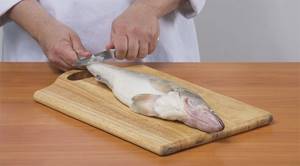
Cleaning fish using a regular kitchen knife.
Cleaning with the back of the knife is done in the same way. It is more time-consuming, but it causes less damage to the skin of the carcass. In addition, this method is recommended for use by those who have little experience in this matter.
Special knife
A more preferable option is to use a special fish knife. The blade of such a knife, as a rule, is not too long, but sufficiently wide. Usually it is somewhat wider than the handle. With this knife you can clean fish faster than with a regular kitchen knife.
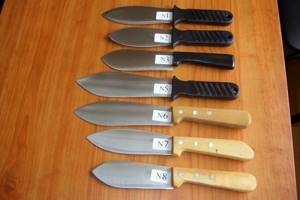
Special knives for cleaning fish from scales.
The cleaning process itself completely repeats cleaning with a regular kitchen knife.
